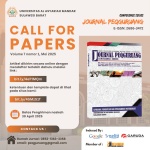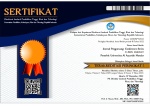Privasi Anak di Media Sosial: Risiko, Tantangan, dan Upaya Perlindungan
Abstract
Perkembangan teknologi digital telah membawa perubahan signifikan dalam cara anak-anak berinteraksi dengan dunia maya, khususnya melalui media sosial. Meskipun media sosial menawarkan berbagai manfaat dalam aspek komunikasi, edukasi, dan hiburan, anak-anak juga menghadapi risiko privasi yang serius. Artikel ini membahas tantangan utama dalam perlindungan privasi anak di media sosial, termasuk pengumpulan dan pemrosesan data oleh platform digital, penyalahgunaan informasi pribadi, serta risiko keamanan siber seperti cyberbullying dan online grooming. Selain itu, artikel ini mengurai kesenjangan antara regulasi yang telah diterapkan dan implementasi kebijakan perlindungan privasi anak di berbagai negara, termasuk General Data Protection Regulation (GDPR) di Uni Eropa dan Children’s Online Privacy Protection Act (COPPA) di Amerika Serikat. Meskipun regulasi ini bertujuan untuk memberikan perlindungan hukum yang lebih baik, tantangan dalam penegakan dan transparansi platform digital tetap menjadi isu yang perlu diperhatikan. Artikel ini juga menyoroti peran berbagai pemangku kepentingan, termasuk orang tua, sekolah, komunitas, dan pemerintah, dalam meningkatkan literasi digital anak serta memastikan keamanan data mereka di dunia maya. Selain itu, inovasi teknologi seperti kontrol orang tua (parental control) dan kecerdasan buatan dalam mendeteksi ancaman daring diidentifikasi sebagai langkah preventif yang dapat meningkatkan perlindungan privasi anak. Sebagai rekomendasi, artikel ini menekankan pentingnya peningkatan kebijakan perlindungan data yang lebih spesifik untuk anak-anak, penguatan inisiatif edukasi digital yang melibatkan berbagai pihak, serta transparansi yang lebih besar dari platform digital dalam mengelola data anak. Dengan pendekatan multidisipliner yang melibatkan regulasi, teknologi, dan pendidikan, diharapkan anak-anak dapat menikmati manfaat media sosial tanpa harus mengorbankan privasi dan keamanan mereka.
Keywords
Full Text:
PDFReferences
Ademiluyi, A., Li, C., & Park, A. (2022). Implications and Preventions of Cyberbullying and Social Exclusion in Social Media: Systematic Review. JMIR Formative Research, 6(1), e30286. https://doi.org/10.2196/30286
Alberto. (2020, December 3). Deep dive into the Edmodo data breach. @4iQ. https://medium.com/4iqdelvedeep/deep-dive-into-the-edmodo-data-breach-f1207c415ffb
Al-Samarraie, H., Bello, K.-A., Alzahrani, A. I., Smith, A. P., & Emele, C. (2021). Young users’ social media addiction: Causes, consequences and preventions. Information Technology & People, 35(7), 2314–2343. https://doi.org/10.1108/ITP-11-2020-0753
Anderson, M. (2016). Parents, Teens and Digital Monitoring. Pew Research Center. https://www.pewresearch.org/internet/2016/01/07/parents-teens-and-digital-monitoring/
Ansorge, R., Gatta, F., & Gopal, A. (2024). Piaget Cognitive Stages of Development. WebMD. https://www.webmd.com/children/piaget-stages-of-development
Art. 8 GDPR – Conditions applicable to child’s consent in relation to information society services. (2018). General Data Protection Regulation (GDPR). https://gdpr-info.eu/art-8-gdpr/
Borj, P. R., Raja, K., & Bours, P. (2023). Online grooming detection: A comprehensive survey of child exploitation in chat logs. Knowledge-Based Systems, 259, 110039. https://doi.org/10.1016/j.knosys.2022.110039
Bozzola, E., Spina, G., Agostiniani, R., Barni, S., Russo, R., Scarpato, E., Di Mauro, A., Di Stefano, A. V., Caruso, C., Corsello, G., & Staiano, A. (2022). The Use of Social Media in Children and Adolescents: Scoping Review on the Potential Risks. International Journal of Environmental Research and Public Health, 19(16), 9960. https://doi.org/10.3390/ijerph19169960
BPS: 88,99% Anak 5 Tahun ke Atas Mengakses Internet untuk Media Sosial | Databoks. (2021). https://databoks.katadata.co.id/teknologi-telekomunikasi/statistik/911fee2b83d9741/bps-8899-anak-5-tahun-ke-atas-mengakses-internet-untuk-media-sosial
Chang, V., Golightly, L., Xu, Q. A., Boonmee, T., & Liu, B. S. (2023). Cybersecurity for children: An investigation into the application of social media. Enterprise Information Systems, 17(11), 2188122. https://doi.org/10.1080/17517575.2023.2188122
Children’s Online Privacy Protection Rule (“COPPA”) | Federal Trade Commission. (1998). https://www.ftc.gov/legal-library/browse/rules/childrens-online-privacy-protection-rule-coppa
CISA. (2023). Partnering to Safeguard K-12 Organizations from Cybersecurity Threats. https://www.cisa.gov/sites/default/files/2023-01/K-12report_FINAL_V2_508c.pdf
Data & Society. (2020). Data & Society. https://datasociety.net/
Doğan Keskin, A., Kaytez, N., Damar, M., Elibol, F., & Aral, N. (2023). Sharenting Syndrome: An Appropriate Use of Social Media? Healthcare, 11(10), 1359. https://doi.org/10.3390/healthcare11101359
Domazet, S., & Šušak-Lozanovska, I. (2023). Children’s data and privacy online: Growing up in a digital age. Politika Nacionalne Bezbednosti, 24(1), 153–173. https://doi.org/10.5937/pnb24-44680
Giumetti, G. W., & Kowalski, R. M. (2022). Cyberbullying via social media and well-being. Current Opinion in Psychology, 45, 101314. https://doi.org/10.1016/j.copsyc.2022.101314
Gohal, G., Alqassim, A., Eltyeb, E., Rayyani, A., Hakami, B., Al Faqih, A., Hakami, A., Qadri, A., & Mahfouz, M. (2023). Prevalence and related risks of cyberbullying and its effects on adolescent. BMC Psychiatry, 23(1), 39. https://doi.org/10.1186/s12888-023-04542-0
Google and YouTube Will Pay Record $170 Million for Alleged Violations of Children’s Privacy Law | Federal Trade Commission. (2019). https://www.ftc.gov/news-events/news/press-releases/2019/09/google-youtube-will-pay-record-170-million-alleged-violations-childrens-privacy-law
Hern, A. (2022, March 24). Sites reported record 29.3m child abuse images in 2021. The Guardian. https://www.theguardian.com/technology/2022/mar/24/sites-reported-record-293m-child-abuse-images-in-2021
Introduction to the Children’s code. (2024, October 22). ICO. https://ico.org.uk/for-organisations/uk-gdpr-guidance-and-resources/childrens-information/childrens-code-guidance-and-resources/introduction-to-the-childrens-code/
Jain, A. K., Sahoo, S. R., & Kaubiyal, J. (2021). Online social networks security and privacy: Comprehensive review and analysis. Complex & Intelligent Systems, 7(5), 2157–2177. https://doi.org/10.1007/s40747-021-00409-7
Jang, Y., & Ko, B. (2023). Online Safety for Children and Youth under the 4Cs Framework—A Focus on Digital Policies in Australia, Canada, and the UK. Children, 10(8), 1415. https://doi.org/10.3390/children10081415
Johnson, A. (2024). How to Address Children’s Online Safety in the United States. https://itif.org/publications/2024/06/03/how-to-address-childrens-online-safety-in-united-states/
Khalaf, A. M., Alubied, A. A., Khalaf, A. M., & Rifaey, A. A. (2023). The Impact of Social Media on the Mental Health of Adolescents and Young Adults: A Systematic Review. Cureus. https://doi.org/10.7759/cureus.42990
Kochenderfer-Ladd, B., Ladd, G. W., & Thibault, S. A. (2022). Children’s Interpersonal Skills and School-Based Relationships. In The Wiley-Blackwell Handbook of Childhood Social Development (pp. 366–385). John Wiley & Sons, Ltd. https://doi.org/10.1002/9781119679028.ch20
KOMDIGI. (2024). Siaran Pers No. 342/HM/KOMINFO/05/2024 tentang Konsultasi Publik RPP mengenai Tata Kelola Pelindungan Anak dalam Penyelenggaraan Sistem Elektronik. https://www.komdigi.go.id/berita/pengumuman/detail/siaran-pers-no-342-hm-kominfo-05-2024-tentang-konsultasi-publik-rpp-mengenai-tata-kelola-pelindungan-anak-dalam-penyelenggaraan-sistem-elektronik
Livingstone, S., Stoilova, M., & Nandagiri, R. (2019). Children’s Data and Privacy Online. LSE Media and Communications. https://eprints.lse.ac.uk/101283/1/Livingstone_childrens_data_and_privacy_online_evidence_review_published.pdf
Livingstone, S., & Third, A. (2017). Children and young people’s rights in the digital age: An emerging agenda. New Media & Society, 19(5), 657–670. https://doi.org/10.1177/1461444816686318
Montgomery, K. C., Chester, J., & Milosevic, T. (2017). Children’s Privacy in the Big Data Era: Research Opportunities. Pediatrics, 140(Suppl 2), S117–S121. https://doi.org/10.1542/peds.2016-1758O
Pasha, S. A., Ali, S., & Jeljeli, R. (2022). Artificial Intelligence Implementation to Counteract Cybercrimes Against Children in Pakistan. Human Arenas, 1–19. https://doi.org/10.1007/s42087-022-00312-8
PIPL. (2021). Personal Information Protection Law of the People’s Republic of China. PIPL. https://personalinformationprotectionlaw.com/
PP No. 71 Tahun 2019. (2019). Database Peraturan | JDIH BPK. http://peraturan.bpk.go.id/Details/122030/pp-no-71-tahun-2019
Quach, S., Thaichon, P., Martin, K. D., Weaven, S., & Palmatier, R. W. (2022). Digital technologies: Tensions in privacy and data. Journal of the Academy of Marketing Science, 50(6), 1299–1323. https://doi.org/10.1007/s11747-022-00845-y
Romero Saletti, S. M., Van den Broucke, S., & Van Beggelaer, W. (2022). Understanding Motives, Usage Patterns and Effects of Instagram Use in Youths: A Qualitative Study. Emerging Adulthood, 10(6), 1376–1394. https://doi.org/10.1177/21676968221114251
Scheinbaum, A. C. (2024). The Darker Side of Social Media: Consumer Psychology and Mental Health. Taylor & Francis.
Stoilova, M., Nandagiri, R., & Livingstone, S. (2021). Children’s understanding of personal data and privacy online – a systematic evidence mapping. Information, Communication & Society, 24(4), 557–575. https://doi.org/10.1080/1369118X.2019.1657164
The State of the World’s Children 2017 | UNICEF. (2017, December 6). https://www.unicef.org/reports/state-worlds-children-2017
The State of the World’s Children 2021 | UNICEF. (2021, October 5). https://www.unicef.org/reports/state-worlds-children-2021
UNESCO. (2021). Media and information literate citizens: Think critically, click wisely! - UNESCO Digital Library. https://unesdoc.unesco.org/ark:/48223/pf0000377068
UU No. 11 Tahun 2008. (2008). Database Peraturan | JDIH BPK. http://peraturan.bpk.go.id/details/37589/uu-no-11-tahun-2008
UU No. 23 Tahun 2002. (2002). Database Peraturan | JDIH BPK. http://peraturan.bpk.go.id/Details/44473/uu-no-23-tahun-2002
We Are Social. (2024, January 31). Digital 2024. We Are Social Indonesia. https://wearesocial.com/id/blog/2024/01/digital-2024/
Wisniewski, P., Ghosh, A. K., Xu, H., Rosson, M. B., & Carroll, J. M. (2017). Parental Control vs. Teen Self-Regulation: Is there a middle ground for mobile online safety? Proceedings of the 2017 ACM Conference on Computer Supported Cooperative Work and Social Computing, 51–69. https://doi.org/10.1145/2998181.2998352
 DOI: http://dx.doi.org/10.35329/jp.v6i2.5996
DOI: http://dx.doi.org/10.35329/jp.v6i2.5996
Article Metrics
 Abstract views : 225 times |
Abstract views : 225 times |  PDF - 118 times
PDF - 118 times
Refbacks
- There are currently no refbacks.
Alamat Penyunting & Distribusi:
JOURNAL PEQGURUANG: Conference Series
E-ISSN: 2686-3472
Gedung Biro AKSI. Lt 2. Ruang Lembaga Penelitian dan Pengabdian Masyarakat Universitas Al Asyariah Mandar
Telp./Fax (0428) 21038
Email: peqguruang@gmail.com
Website: https://journal.lppm-unasman.ac.id/index.php/peqguruan/index
Penerbit:
Lembaga Penelitian dan Pengabdian Masyarakat Universitas Al Asyariah Mandar
Indexed by:
Member of:

JOURNAL PEQGURUANG: Conference Series is licensed under a Creative Commons Attribution-ShareAlike 4.0 International License.










